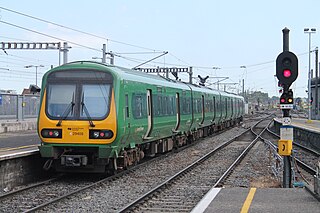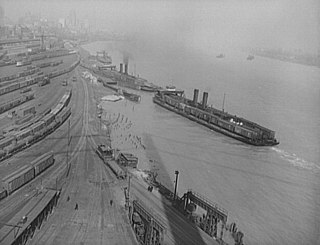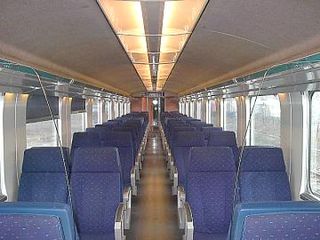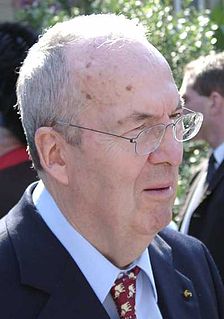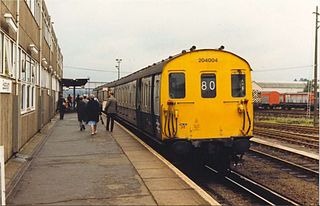
The British Rail Class 204 designation has been used twice for two similar types of diesel-electric multiple units.

The British Rail Class 118 diesel multiple units were built by the Birmingham Railway Carriage & Wagon Company (BRCW) and introduced from 1960.

Enterprise is the cross-border inter-city train service between Dublin Connolly in the Republic of Ireland and Belfast Lanyon Place in Northern Ireland, jointly operated by Iarnród Éireann (IE) and NI Railways (NIR). It operates on the Belfast–Dublin railway line.

The British Rail Class 201 six-car diesel-electric multiple units (DEMUs) were built in 1957-1958 at Eastleigh and underframes were built at Ashford.
Push–pull is a configuration for locomotive-hauled trains, allowing them to be driven from either end of the train, whether having a locomotive at each end or not.
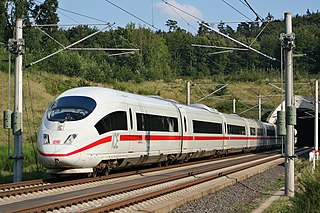
An electric multiple unit or EMU is a multiple-unit train consisting of self-propelled carriages, using electricity as the motive power. An EMU requires no separate locomotive, as electric traction motors are incorporated within one or a number of the carriages. An EMU is usually formed of two or more semi-permanently coupled carriages, but electrically powered single-unit railcars are also generally classed as EMUs. The great majority of EMUs are passenger trains, but versions also exist for carrying parcels and mail.
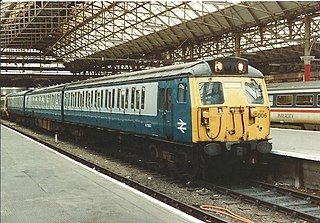
The British Rail Class 304 electric multiple units were built for suburban use on the first phases of the West Coast Main Line electrification between Crewe and Manchester/Liverpool/Rugby. Originally classed as AM4 units, they later became Class 304 under the TOPS numbering system, and could be found in operation over most of the West Coast Main Line. The units conformed to the 1959-design for alternating current (AC) electrical multiple units, and were externally very similar to the Class 305, Class 308 and the 1,200 V direct current (DC) Class 504 units. No units survived into preservation, and all units were eventually scrapped.
British Railways Class 505 were 1,500 V DC electric multiple units (EMUs) introduced in 1931 by the Manchester, South Junction and Altrincham Railway (MSJAR). Although assigned to TOPS Class 505 by British Railways, these units were withdrawn before the TOPS numbering system came into common use for multiple units, and the Class 505 designation is very rarely used.

The British Rail Class 126 diesel multiple unit was built by BR Swindon Works in 1959/60 to work services from Glasgow to Ayrshire and comprised 22 3-car sets based on the earlier Swindon-built trainsets that had been introduced in 1955 to work the Edinburgh Waverley - Glasgow Queen St services. These vehicles formed the first Inter City service to be operated by diesel units in Great Britain. The introduction of these early diesel multiple units originated in a British Transport Commission report of 1952 that suggested the trial use of diesel railcars. BR's Swindon Works were chosen to design and build express units for the ex-North British Railway Edinburgh Waverley to Glasgow Queen Street route.
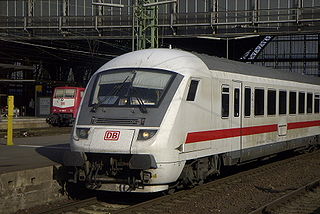
A control car, control trailer or driving trailer is a generic term for a non-powered railroad (US) or railway (UIC) vehicle that can control operation of a train from the end opposite to the position of the locomotive. They can be used with Diesel or electric motive power, allowing push-pull operation without the use of an additional locomotive. They can also be used with a power car or a railcar. In a few cases control cars were used with steam locomotives, especially in Germany and France.

For servicing suburban commuter lines, electrified on 25 kV, AC, the Railcar Manufacturing Plant of Riga produced ER9, then ER9p electric trainsets in the 1966-1975 period. The mass production of these trains had begun in 1964.

Class 624 and class 634 are types of diesel multiple unit, originally operated by Deutsche Bahn.
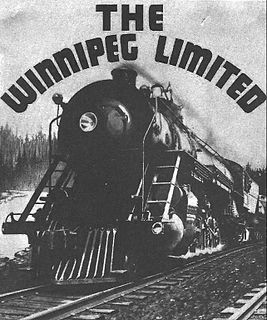
The Winnipeg Limited was an overnight named passenger train operated by the Great Northern Railway 457 miles (735 km) between St. Paul-Minneapolis and Winnipeg, Manitoba. It competed on the route with the overnight Winnipeger of the Minneapolis, St. Paul and Sault Ste. Marie Railway, and the Northern Pacific Railway's unnamed daytime passenger train.

The DBAG Class 605, commonly known as the ICE TD was a high-speed diesel multiple unit (DMU) train, in service with Deutsche Bahn and DSB.
The Eilzugwagen was a type of railway passenger coach specially developed for German semi-fast trains, known as Eilzüge. These coaches were first built in the 1930s and continued to be produced until the 1950s. Today all coaches of this type have been retired. A number still run on museum railways.

The DB Class 614s are German diesel multiple units operated by the Deutsche Bundesbahn, comprising two Class 614 driving units and up to two Class 914 centre cars. On 1 January 1994 the ownership of these vehicles was transferred to the DB's legal successor Deutsche Bahn AG and its subsidiaries or business areas.

St Philip's Marsh depot is a railway depot located in the St Philip's Marsh district of Bristol, England. It was established as a steam locomotive shed in 1910 but this facility closed in the 1960s. A new diesel facility opened nearby at Marsh Junction in 1959). This has since been combined with a new shed which was opened in 1976 to maintain new InterCity 125 trainsets.

Diesel multiple units and railcars are trains, usually with passenger accommodation, that do not require a locomotive. Railcars can be single cars, while in multiple units cars are marshalled together with a driving position either end. As of December 2010, 23 percent of the rail passenger cars used on Network Rail are part of an diesel multiple unit.

The Resort Shirakami is a limited-stop "Rapid" service operated by the East Japan Railway Company as a sightseeing train along the scenic coastal Gono Line in the north of Japan since March 1997.
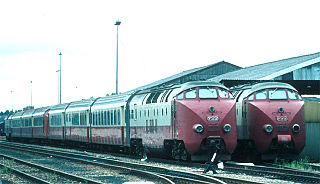
The SBB-CFF-FFS RAm TEE I and NS DE4 were a class of five 4-car diesel-electric trainsets ordered for Trans Europe Express (TEE) service. Two were ordered by the Swiss Federal Railways (SBB-CFF-FFS) and three by Nederlandse Spoorwegen (NS)
